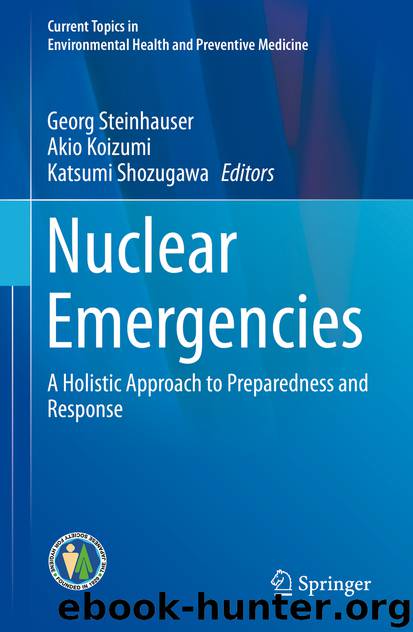Nuclear Emergencies by Unknown

Author:Unknown
Language: eng
Format: epub
ISBN: 9789811383274
Publisher: Springer Singapore
Evaluation: After the crisis, it is important to evaluate whether the chosen strategies, tactics, and measures have been chosen correctly. The objective in this context is learning for the future respectively being prepared for upcoming crises.
9.3 Practice: Case Studies
9.3.1 Fukushima (Japan)
On Friday March 11, 2011, the day when the disaster in Fukushima occurred, I had been going for a walk in my hometown Langau and received urgent phone calls from journalists from the Austrian Broadcasting Company (ORF) and the Austrian Newspaper Der Standard. Each of them wanted to talk to a nuclear expert about the accident and the current situation at the NPP Fukushima Daiichi. As the university’s spokesperson, I had to rely on my univeristy-wide (internal) network to the relevant experts and could easily provide the media with reliable contacts at TU Wien. When the triple-disaster in Fukushima occurred, the colleagues at the Institute of Atomic and Subatomic Physics in Vienna (ATI) proved to be communication professionals. As a globally acting technical university with its focus on research, one of the duties of our scientists is to communicate and offer a rational evidence based expertise, especially in case of an emergency. When the disaster evoked, tremendous insecurity and fear all around the world and also among the people of Austria, they helped and transferred unbiased information. While universities usually complain about lack of funding and understaffing, the flexibility of a university with its student volunteers as a highly motivated human resource made it possible to quickly set up an “Information Center.” Here, dozens of enthusiastic students, under the guidance of the nuclear experts at the ATI, researched for reliable information and answered urgent questions by the media and the concerned public via e-mail and phone [9]. The work of the Information Center made the ATI and TU Wien “the source point for the most recent and most reliable information available about the Fukushima nuclear accident in Austria” (ORF, Zeit im Bild 2, March 2011). Within weeks, the ATI and its Information Center provided expert information for 28 TV interviews, 26 radio interviews, and 52 print and online media interviews. Further, it provided unbiased and personalized information for approximately 900 inquiries by private individuals who had contacted the Information Center via e-mail or telephone [9]. While news organizations often struggle with a lack of manpower that would be needed upon a sudden crisis, a university—when endowed with a positive spirit—can rely on the availability of enthusiastic students who will be more competent in assessing the quality of potentially dubious raw data than journalists.
The experts at ATI took responsibility, referring to the university’s mission statement “technology for people”. Let me quote Prof. Georg Steinhauser (then at the ATI), who replied to a heckler during a public speech in the Austrian Federal Ministry of Health, why he would always emphasize his expression of hope when talking about the Fukushima accident and not embark on possible worst-case scenarios, “People are genuinely afraid of radiation already. I firmly believe that it is the obligation of science to allay this fear, not to fuel it.
Download
This site does not store any files on its server. We only index and link to content provided by other sites. Please contact the content providers to delete copyright contents if any and email us, we'll remove relevant links or contents immediately.
Still Foolin’ ’Em by Billy Crystal(36300)
We're Going to Need More Wine by Gabrielle Union(18997)
Plagued by Fire by Paul Hendrickson(17366)
Pimp by Iceberg Slim(14431)
Molly's Game by Molly Bloom(14100)
Becoming by Michelle Obama(9967)
When Breath Becomes Air by Paul Kalanithi(8362)
Educated by Tara Westover(7990)
The Girl Without a Voice by Casey Watson(7841)
Note to Self by Connor Franta(7643)
The Incest Diary by Anonymous(7628)
How to Be a Bawse: A Guide to Conquering Life by Lilly Singh(7425)
The Space Between by Michelle L. Teichman(6889)
What Does This Button Do? by Bruce Dickinson(6164)
Imperfect by Sanjay Manjrekar(5831)
Permanent Record by Edward Snowden(5791)
A Year in the Merde by Stephen Clarke(5365)
Shoe Dog by Phil Knight(5214)
Promise Me, Dad by Joe Biden(5109)
